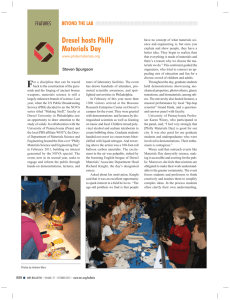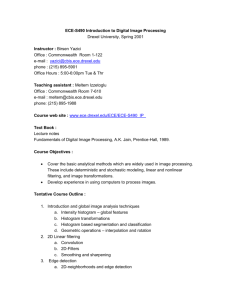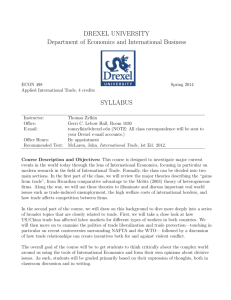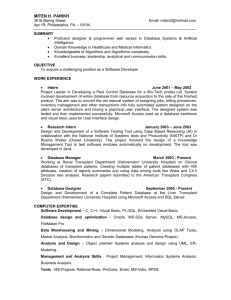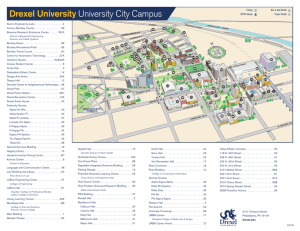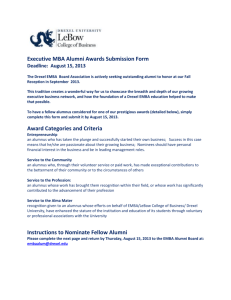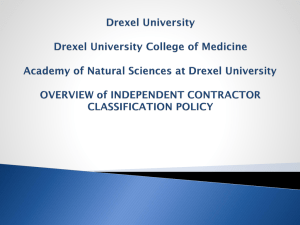Drexel Goes Wireless Leading U. S. University Creates Fully
advertisement
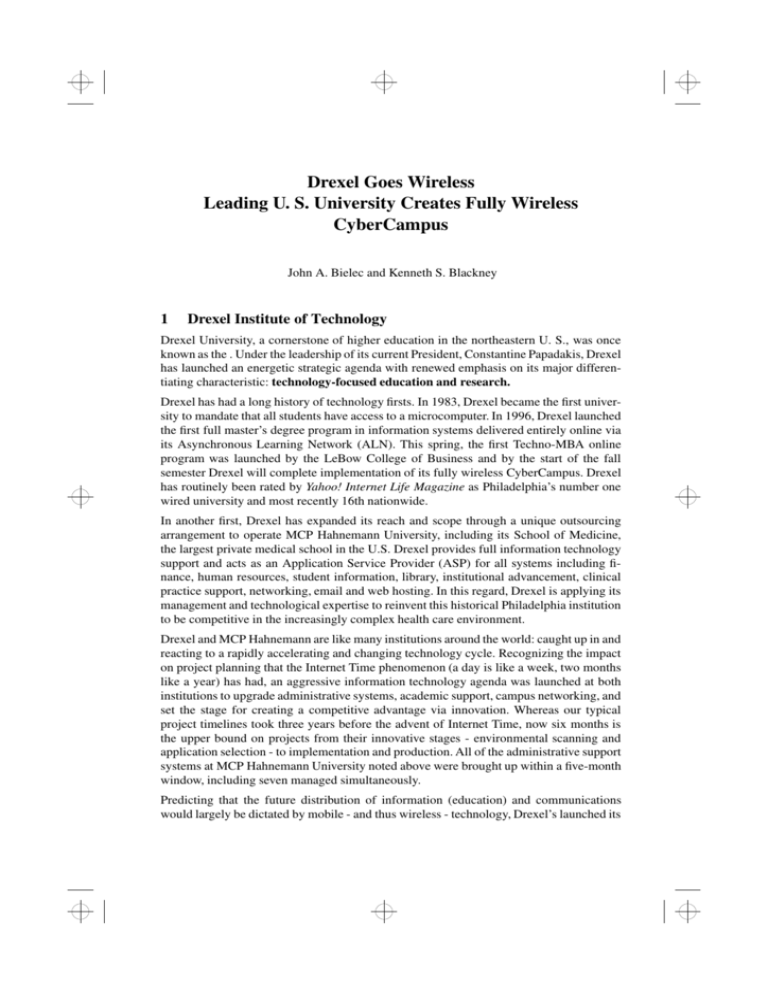
Drexel Goes Wireless Leading U. S. University Creates Fully Wireless CyberCampus John A. Bielec and Kenneth S. Blackney 1 Drexel Institute of Technology Drexel University, a cornerstone of higher education in the northeastern U. S., was once known as the . Under the leadership of its current President, Constantine Papadakis, Drexel has launched an energetic strategic agenda with renewed emphasis on its major differentiating characteristic: technology-focused education and research. Drexel has had a long history of technology firsts. In 1983, Drexel became the first university to mandate that all students have access to a microcomputer. In 1996, Drexel launched the first full master’s degree program in information systems delivered entirely online via its Asynchronous Learning Network (ALN). This spring, the first Techno-MBA online program was launched by the LeBow College of Business and by the start of the fall semester Drexel will complete implementation of its fully wireless CyberCampus. Drexel has routinely been rated by Yahoo! Internet Life Magazine as Philadelphia’s number one wired university and most recently 16th nationwide. In another first, Drexel has expanded its reach and scope through a unique outsourcing arrangement to operate MCP Hahnemann University, including its School of Medicine, the largest private medical school in the U.S. Drexel provides full information technology support and acts as an Application Service Provider (ASP) for all systems including finance, human resources, student information, library, institutional advancement, clinical practice support, networking, email and web hosting. In this regard, Drexel is applying its management and technological expertise to reinvent this historical Philadelphia institution to be competitive in the increasingly complex health care environment. Drexel and MCP Hahnemann are like many institutions around the world: caught up in and reacting to a rapidly accelerating and changing technology cycle. Recognizing the impact on project planning that the Internet Time phenomenon (a day is like a week, two months like a year) has had, an aggressive information technology agenda was launched at both institutions to upgrade administrative systems, academic support, campus networking, and set the stage for creating a competitive advantage via innovation. Whereas our typical project timelines took three years before the advent of Internet Time, now six months is the upper bound on projects from their innovative stages - environmental scanning and application selection - to implementation and production. All of the administrative support systems at MCP Hahnemann University noted above were brought up within a five-month window, including seven managed simultaneously. Predicting that the future distribution of information (education) and communications would largely be dictated by mobile - and thus wireless - technology, Drexel’s launched its 302 John A. Bielec and Kenneth S. Blackney first ”CyberZone” pilot in late 1997 in its Hagerty Library. Using Lucent Technologies’ WaveLan products (now the Orinoco product line from Avaya Communications, Lucent’s spun-off Enterprise Networks Division), Drexel created the first 100% wireless library in the world. For three years students and staff have borrowed laptop computers (at no charge) to access systems on the Drexel network - including email and online course materials and elsewhere on the Internet. The new environment created a unique opportunity for Drexel students to combine various electronic and database information sources with traditional library resources independent of location. Laptop checkouts averaged over 3,000 per month. Building on success of its joint initiative with the library, the Office of Information Resources and Technology created additional CyberZones in the Creese Student Union, where students could relax and do a little web surfing while visiting the café; the Korman Computing Center, to provide professors with the ultimate in classroom flexibility; and the LeBow College of Business, for classrooms, lecture halls and computer laboratories. The first CyberZones at MCP Hahnemann University were created just a few months after Drexel began its operating agreement. Further, the universities were using the same IEEE 802.11b -compliant equipment to provide a link between two of the campuses while its new OC-48 SONET ring Metropolitan Area Network was under construction. In March 2000, Lucent provided Drexel with a roadmap of its planned upgrades to its Orinoco wireless products. New access points, software and PC Cards would make it easier to provide robust, secure and scalable wireless network access in public areas such as airports, convention centers, businesses, schools and libraries. The new PC Cards employed 128 bit encryption like that used by e-commerce web sites. The new software enables the university to implement a security scheme to keep unauthorized users from accessing the network. The new access points provide the university with two key advantages over the previous generation of equipment: there is no need for electrical outlets near each access point (initial budgets showed that the electrical costs would be over half of the project costs; the new equipment cut that to 15%) and the access points have a 100 Mbps Ethernet uplink (ten times faster than the previous generation) so that they can support much faster PC Cards as they are developed. A new wireless network is not implemented in a vacuum. Wireless networking is dependent on a robust wired infrastructure to carry network traffic from the nearest wireless access point to the servers on your network and the routers that connect you to the Internet. Fortunately, Drexel had recently invested over $5 million in upgrading its wired infrastructure (indeed, every piece of network equipment and almost every network jack on campus was replaced). Based on two years of successfully piloting the Lucent wireless technology and its recent network infrastructure upgrade, Drexel was well positioned and was able to immediately ”leap-frog” forward to provide full wireless access on it’s 52 building campus. Leveraging the wired network infrastructure, Drexel’s plan called for the rapid rollout of additional CyberZones across both the Drexel and MCP Hahnemann campuses, including both indoor and outdoor areas so that ubiquitous networking at both institutions will be a reality. Students, faculty and staff who have laptop computers or other portable devices will be able to connect to the network from anywhere at any time while on campus. Drexel Goes Wireless 303 The public announcement of the wireless campuses plan was made on June 12, 2000 at Drexel’s commencement ceremonies. In his announcement university president Constantine Papadakis told the graduates and the world that Drexel’s entire campus - inside and out - would have wireless network service by the fall semester. The first step, creating the world’s first fully wireless School of Medicine, was to be complete in just 49 days. Another 49 days were allotted to build Drexel’s own CyberCampus and a final 49 days to complete the rest of MCP Hahnemann University. The project was to take just 21 weeks. Lucent hadn’t yet released the equipment that Drexel planned to use, however, the Office of Information Resources and Technology had extensive experience with such rapid roll-outs. Such are projects in the age of Internet Time. From a planning perspective, the project to provide pervasive wireless networking at the School of Medicine should have been easy. Of the three phases of the project, this was the smallest by a significant factor. However, ten days before the network was to be completed, Lucent confirmed that the new equipment that was to have been deployed at the School would not be ready until after the implementation deadline. As a stop-gap, Lucent lent and Drexel installed the previous generation of equipment knowing that it would be uninstalled it just two weeks. The last of the those wireless access points was turned on at 7:30 AM on August 1, 30 minutes ahead of deadline. Drexel’s campus poses the largest set of implementation challenges. The campus is relatively large (60+ acres), is divided by numerous city streets, contains a mix of buildings with widely different construction materials, and already has an extensive Ethernet network employing many sub-networks. Providing ubiquitous networking in such an environment could be difficult and expensive. To address these issues and save time the project duties was assigned to separate interior and exterior networking teams. The interior team used the experience it gained over two years of deploying wireless CyberZones at Drexel and MCP Hahnemann to determine the number of access points that would be needed (140) for full building coverage (excluding residence halls) and the placement for each. The exterior team worked with property records, aerial photographs (including satellite images) and campus walks to do the same for outdoor coverage. Further, they planned to go beyond the stated project goals by providing wireless networking service in the residence halls and to so in a novel way: from the outside looking in. See diagram for coverage areas and the placement of the 40 outdoor access points. To provide wireless effective roaming capability, a user’s IP address cannot change as he or she moves from one access point to another because doing so would disrupt ongoing communications such as streaming video or a web-based application. This presented a problem at Drexel since the wired network was designed to make extensive use of subnets to minimize broadcast traffic. Indeed, the campus itself is divided into four regions, each with its own regional router. Each building in a region is a collection of one or more subnets connected to a regional router. The regional routers are interconnected using Gigabit Ethernet. (For reference, these four regions are North campus for residential and academic use, Central campus for academic and support services, East campus for academic and administrative uses, and the central data center inside the Korman Center in the Central region for centralized servers and network services, including links to the Internet, Internet2, private networks and our Metropolitan Area Network.) 304 John A. Bielec and Kenneth S. Blackney To solve the roaming problem virtual local area networks (VLANs) were implemented to allow the 180 access points to be members of a single VLAN spread all over campus and created expressly for the wireless project. Further, the VLAN was extended over the university’s Metropolitan Area Network so that wireless roaming among the three campuses becomes possible. (Of course, connectivity is lost while in transit between one campus and another.) ”A CyberCampus will improve our students’ overall college experience by giving them greater freedom and mobility,” Papadakis said. ”With Internet access from anywhere on campus - dining halls, outdoors on campus benches or in classrooms - there will also be greater collaboration among students.” ”Going wireless will become a major trend in higher education. Other schools will be following our lead in the near future,” said Papadakis, who presides over the 60+ urban acre campus that is 10 minutes from historic Independence Hall and has more than 12,000 students. Complementing wireless connectivity is high-speed upstream connectivity. Students, faculty and staff at Drexel and MCP Hahnemann have access to the commodity Internet at 45 Mbps, twice the speed available in June 2000 and half that it will be by June 2001. Additionally, Drexel is one of approximately 170 Universities in the U.S. that are active members of Internet 2 and is also a recipient of NSF Next Generation Internet (NGI) funding. As a result, researchers at Drexel and MCP Hahnemann University have access to Internet2 at a speed of 155 Mbps. Our connections to this high performance network Drexel Goes Wireless 305 provides Drexel and MCP Hahnemann University with access to other institutions wishing to do collaborative research. Drexel University has recognized that ”innovation” facilitation is an important component of keeping ahead of the technology curve. It has become increasingly clear that any Information Technology support strategy must go through some process of re-invention every few years or go the way of the dinosaur - traditional continuous improvement or incremental change is effectively non-responsive to today’s challenges. Last year’s Philadelphia Mayoral debates were web cast live over the Internet from Drexel’s Mandell Theater - who would have thought of this application a few years ago? But even that application - a fixed-location wired camera transmitting its video signal seems dated when wireless networking is available. Drexel has now developed a portable web cast backpack that includes a small video camera and a computer with both video capture and wireless networking capabilities. Now, events anywhere on campus can be web cast live with ease. John A. Bielec, Ph.D., is Vice-President of Information Resources and Technology/CIO, at both Drexel University and MCP Hahnemann University. Dr. Bielec has over 20 years of extensive involvement in university programs and administration. Prior to coming to Drexel he served in many faculty and administrative posts at the University of Maryland, including the Vice Chancellor for Administrative Affairs at College Park, the American 306 John A. Bielec and Kenneth S. Blackney University, Johns Hopkins University, Bowie State University, and the Smithsonian Institution. He holds a doctorate degree from the School of Public Affairs at the University of Maryland in Public Policy and Administration. He is a frequent speaker at National and International conferences Dr. Bielec is one of a select few United States University Administrators who spent time in the United Kingdom (University of Warwick and University Grants Committee) as part of the UK/US Fulbright Administrative Exchange Program. Dr. Bielec serves as the United States liaison to EUNIS (European University Information Systems Organization), headquartered in Paris, representing its 21 member nations on collaborative initiatives with U.S. institutions and associations. For more information please see http://www.pages.drexel.edu/~jbielec Kenneth S. Blackney, is Director of Core Technology Infrastructure at both Drexel University and MCP Hahnemann University. Mr. Blackney has been with Drexel for 12 years in roles including academic support, application development, technology assessment, and his current position overseeing Networking and Systems. He has spoken and presented papers at conferences in the United States and Europe and is frequently interviewed on the topics of networking technology and computer security. For more information please see http://ksb.irt.drexel.edu/.
